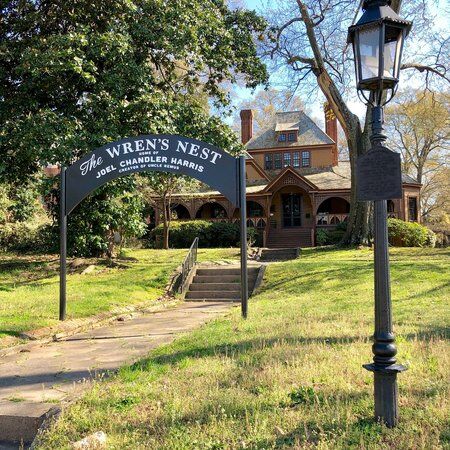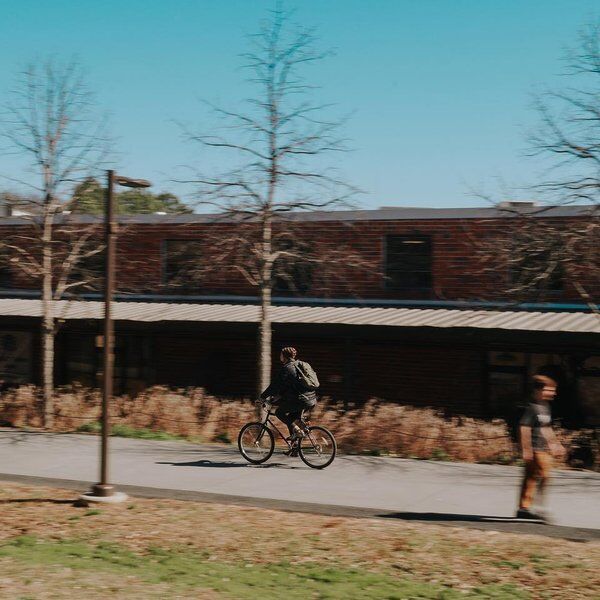Discover The Wren’s Nest in Atlanta
The Wren’s Nest is situated in Atlanta’s historic West End neighborhood. The charming property, now Atlanta’s oldest house museum, once served as the home of Joel Chandler Harris, the celebrated author and journalist known for the beloved Uncle Remus tales and the iconic Brer Rabbit stories. Designated a National Historic Landmark, The Wren’s Nest is Harris’s legacy; preserving it through the art of storytelling.
With regards to its architectural value, The Wren’s Nest is an example of late Victorian-era architecture, with Queen Anne and Eastlake-style details. Inside there are original furnishings, colorful period paint, and historical artifacts. These carefully maintained features offer a rare glimpse into life at the turn of the 20th century, allowing the home to acts as a time capsule since it transitioned into a museum in 1913.

Who was Joel Chandler Harris?
Joel Chandler Harris was born in 1845 in Eatonton, Georgia, to a single mother of Irish descent. His early years were marked by hardship, yet they also ignited a lifelong passion for literature. Living in a modest cabin behind the estate of a wealthy doctor who financed his education, Harris found work as a teenager at The Countryman, a newspaper published on the Turnwold Plantation.
It was during his time at Turnwold that Harris first encountered the oral storytelling traditions of enslaved African Americans, which profoundly influenced his later works. Listening to tales of Brer Rabbit and other cunning creatures, he developed a deep appreciation for folklore that would define his career.
After the Civil War, Harris pursued a career in journalism, working for various publications before settling in Atlanta in 1876. Joining The Atlanta Constitution, he began writing dialect stories, which soon introduced the character Uncle Remus—a fictional storyteller who recounted the folktales Harris had cherished since his youth.
Creating Uncle Remus
In 1880, Harris published his first collection, Uncle Remus: His Songs and His Sayings – Folklore of the Old Plantation. This groundbreaking work became an international sensation, translated into 17 languages soon after its release. Central to these stories is Brer Rabbit, a clever trickster character who uses wit to outsmart foes like Brer Fox.
While Harris popularized the rabbit trickster in American literature, this archetype has deep roots in African and Native American traditions. For example, in Nigerian Yoruba mythology, the trickster figure Eshu serves as a mediator between humans and divine beings. Similarly, the Muscogee-Creek people tell stories of Chufi, a rabbit who faces challenges with humor and ingenuity.

Joel Chandler Harris and The Wren’s Nest
In 1881 Harris began renting The Wren’s Nest, a modest farmhouse built around 1868. The three-room home was located in an Atlanta neighborhood once home to the city’s affluent elite. By 1883, the success of his first book enabled him to purchase the home, where he resided with his family until his death in 1908.
Over the years, the property underwent significant changes with the help of architect George P. Humphreys. This included a six-room expansion in 1884, which transformed the house into a striking example of Queen Anne-style architecture. Other key additions included a large wraparound porch, indoor plumbing, and electricity, which reflected the lifestyle of Atlanta’s upper-middle-class families during that era.
Originally named "Snap Bean Farm" as a playful nod to Eugene Field’s "Sabine Farm," Harris renamed the property "The Wren’s Nest" after discovering a family of wrens nesting in the mailbox in 1895. The nest inspired the iconic name that remains to this day and the recreated mailbox is currently one of the home’s most whimsical features.
During Harris’ residence at The Wren's Nest, the home was visited by Indiana poet James Whitcomb Riley, who delighted Harris’s children with his stories. They even affectionately nicknamed him “Uncle Jeems.”

Becoming a Museum
Following Harris’s death, efforts to preserve his legacy quickly gained momentum. With financial support from steel magnate Andrew Carnegie and former President Theodore Roosevelt, the house was established as a museum in 1913. Students from Atlanta Public Schools also played a pivotal role in fundraising for its transformation.
Initially, part of the home operated as the Uncle Remus Memorial Carnegie Library, a branch of the Atlanta Public Library, until 1930. In 1962, The Wren’s Nest received National Historic Landmark status, cementing its place as a vital cultural institution.
Over the years, the museum has continued to evolve. Professional storytellers bring the traditions of African American folklore to life every Saturday, captivating audiences with tales that celebrate the art of oral storytelling. The museum also hosts events like the Jazz Matters concert series and an annual holiday celebration honoring Harris’s December birthday.
One of the most impactful initiatives is the Wren’s Nest Scribes Program, which pairs middle school students with professional writers to craft and publish original stories. These works are later showcased at the Decatur Book Festival, highlighting the museum’s commitment to nurturing the next generation of storytellers.
Legacy and Controversy Surrounding Harris’ Tales
Over the years, Harris published 35 books and countless articles (20 of which were penned at The Wren's Nest), leaving an impact on American literature and inspiring the likes of Mark Twain and Rudyard Kipling.
In recent decades however, his Uncle Remus tales have sparked debate over their portrayal of racial stereotypes through a lens of plantation nostalgia. As well as the dynamics of storytelling in the context of the American South.
While the stories were initially celebrated for preserving African American folklore, modern perspectives highlight the need for critical examination of their cultural impact.

Storytelling at The Wren’s Nest
Despite recent controversy concerning Harris’ tales, The Wren’s Nest continues to run its live storytelling programs with support from organizations like the Georgia Council for the Arts and the National Endowment for the Arts. Every Saturday at 1:00pm, skilled storytellers bring the vibrant tales of Brer Rabbit and other folklore to life, captivating audiences.
The stories told here are brought to life with songs, props, and vibrant energy, serving not only as entertainment but also as cultural preservation. Lasting approximately 25–35 minutes, in spaces designed to seat up to 25 adults, these sessions are family-friendly and well worth a visit if you’re in the area.
Storytellers at The Wren’s Nest
The Wren’s Nest has an impressive roster of storytellers, many of whom are affiliated with leading storytelling organizations like the Kuumba Storytellers of Georgia and the National Association of Black Storytellers.
Gwendolyn J. Napier
Known as "Miss LuvDrop," Gwendolyn uses music, movement, and props to bring her stories to life. She draws inspiration from her travels to West Africa and aims to foster connections between past and present through her storytelling.
Chetter Galloway
With a repertoire rooted in African folktales, Chetter incorporates drumming and audience participation to create immersive performances. His tales range from traditional folklore to personal narratives.
Deborah Strahorn
Deborah believes storytelling is the “voice of literacy.” A veteran performer and educator, she combines her passion for storytelling with literacy programs, making her performances educational and entertaining.
Josie Bailey
Josie blends theatrical elements with African American folklore, taking audiences on educational adventures through her performances. Her stories often include classic figures like Anansi and Uncle Remus and she brings her stories to life through laughing yoga and dance.
Christine Arinze Samuel
Also known as Sistah “Olufemi,” Christine brings her passion for storytelling to life through drumming, singing, and her knowledge of African American history and culture.

Visiting The Wren’s Nest
Opening Times
The Wren’s Nest is open to the public on Saturdays from 11:00 am to 3:00 pm, making it the perfect weekend outing. It’s important to note that the museum is closed on major holidays such as Memorial Day Weekend, Independence Day Weekend, Thanksgiving Day (November 30), and during a winter break from Christmas through New Year’s Day.
Admission Rates
Effective August 1, 2024, the following rates apply:
- Adults: $14
- Students and Seniors: $12
- Children (Ages 3–10): $10
For those interested in private storytelling performances outside of the included Saturday session, a flat fee of $150 applies.
Historic House Tours
Guided tours are offered on Saturdays at 11:00 am, 12:00 pm, 1:30 pm, and 2:00 pm. Each 30–45 minute guided tour delves into the life of Joel Chandler Harris, the significance of Brer Rabbit folktales, and Atlanta’s history as reflected in the city’s oldest house museum.
Visitors will be able to explore the beautifully preserved rooms, complete with Harris family heirlooms and period furnishings, and stroll through the natural grass amphitheater that seats over 800 people. The amphitheater hosts a variety of performances and events, including seasonal concerts and educational programs.
Guests are encouraged to purchase timed tickets in advance. Walk-up tickets are also available, but for those planning to attend both the guided tour and the live storytelling session, selecting the 1:00 pm ticket option is recommended. If online ticket sales have closed for a specific date, you can contact the Wren’s Nest office at 404-753-7735 to make alternative arrangements.
Parking and Directions
Free parking is available onsite, with space for up to 15 full-sized vehicles. Travel and tour vans are welcome, although buses may face challenges due to the driveway layout. If you anticipate needing additional parking, arrangements can be made for offsite locations.
- By MARTA: Five blocks west of the West End Station (S2), it’s a 10-minute walk or a short ride on the #71 bus.
- By Car: From I-20, take exit 55A to Lowery Blvd and head south. Turn right onto Abernathy Boulevard. The Wren’s Nest is two blocks down, just beyond West Hunter Street Baptist Church.
- By BeltLine: Only 0.6 miles from the Atlanta Beltline Westside Trail, it’s an easy walk or bike ride.
Tips for Your Visit
- Tours allow photography, but flash photography is discouraged.
- A single, non-historic restroom is available onsite.
- Visit the gift shop to purchase books, toys, and keepsakes related to The Wren’s Nest and its stories.
- The Wren’s Nest is wheelchair-accessible, with ramps and pathways to accommodate guests with mobility needs.

Explore Beyond The Wren’s Nest with CityDays
Not quite ready to come back to reality after hearing a story at The Wren’s Nest? With CityDays you don’t have to.
We offer scavenger and treasure hunt tours across Atlanta and around the world, perfect for team-building exercises or just a fun day out with friends and family.
Discover hidden gems, solve puzzles, and learn fascinating facts on our From The Ashes Atlanta hunt. Whether you’re a local or a visitor, CityDays will help you uncover the secrets of Atlanta and beyond.














